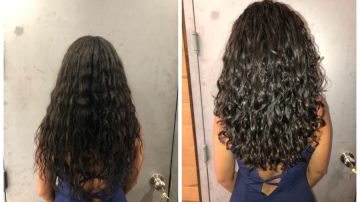Why a Curly Cut Is Crucial When Transitioning From Heat-Damage To Healthy Curls
It’s taken a REALLY long time for my curls to recover from heat-damage—almost 5 years to be exact

Photo: Courtesy of Johanna Ferreira
It’s taken a REALLY long time for my curls to recover from heat-damage—almost 5 years to be exact. But trust me, this isn’t the norm. I’ve always had very long hair and for the longest, letting go of my length was harder than the trauma of loosing my curls—if you can believe that. I started off just trimming, followed by a couple of shoulder-length cuts but it was my lob cut in 2017 that really started to speed things up when it came to my curls finally bouncing back. And while most curly girls—not stubborn ones like me—would have done away with heat-styling by that point. I didn’t. I chose to wait. I went from weekly blowouts to wash and roller sets at my local Dominican salon once a month (often times less) and did see a tremendous improvement. In fact, my Dominican stylist unlike most Dominican stylists, did a lot to save my hair. But I held off for a while on the curl cut. I told myself I was going to wait until my hair got crazy long again before I took the deep plunge.
I’d be lying if I told you I wasn’t anxious about getting a curl cut. I got one years ago when I first learned I had heat-damage and absolutely hated it. My heat-damage was so severe that my hair was straight/wavy from roots to ends, so it didn’t make much of a difference—just left me with an awful shape. I had also heard more stories than I could count about curly girls going in with long manes and coming out with short curly fros—which was NOT what I wanted.
After the summer, I noticed that my hair worn curly had now reached passed boob length with most of my curl pattern almost back. But the weak, wavy ends were killing me. I reached out to a couple of my curly haired friends in the community and few peeps highly recommended curly hair expert and stylist, Joseph Boro of Curls on Fifth. Joseph’s background includes years of working at Devachan salon and training in curl cut. People travel from across the country just to sit in his chair and have him cut their hair. Apparently we recognized each other from way back when, back when he styled my hair at Devachan Salon when I was an intern with healthy curls at Self magazine.
I was nervous but I knew it was time to make the leap. After years of wearing my hair both ways—straight or curly—I was ready for the full-time curly life. I was also ready to finally say goodbye to those wavy dead ends that were holding my curls from bouncing the way nature intended them to. So before the month of September ended, I sat in Joseph’s chair and let him do the cut. I’ve been in love ever since.
Before my cut, Joseph emphasized the importance of getting not just any ol’ haircut but the curl cut, especially for curly girls struggling with heat-damage or damage from chemical treatments such as bad dye jobs, relaxers or Brazilian Keratins.
“The reason a curl cut is crucial during transition is to give your curls the right shape and remove as much of the dead ends,” he said. “A curl cut is different because we cut the hair dry working with your natural pattern, curl by curl, seeing it at its natural state.”
Joseph cut my hair dry and honored my desire to maintain most of my length. He probably only cut two to three inches from the back at most, adding gorgeous layers across my head—especially in the front to help frame my face. I noticed a drastic difference.


“The reason we cut the hair dry is because you don’t wear your hair wet,” he said. “Curly hair has a spring factor that can be under estimated when it’s wet. When the hair is wet it stretches and you can’t see how the curls lays in its natural state.”

Best part is, my curls have only looked even better since the cut. They spiral, they’re bouncy, silky soft and rarely ever frizz up, which is the complete opposite of what I was dealing with. In fact, I’ve had more good hair days than bad hair days since the cut and it’s only been a month and I’m pretty positive my hair has already grown a full inch—maybe a little more.

Joseph made sure to offer me a ton of tips before I left his salon though. Rule number one was to do away with any heat-styling—at least for 3 months—if I wanted to see significant improvement in my curl health. I haven’t heat-styled at all since. He highly recommended loading my hair with moisture, which I was already doing by cleansing my hair with a conditioning co-wash, conditioning my hair regularly and always layering on a highly hydrating leave-in conditioner to my hair before applying my favorite styling product, Camile Rose Natural Curl Maker. This light-weight gel not only keeps my curls bouncy, perfectly defined and frizz-free—but unlike most gels it leaves my rizos silky soft.
I tend to do deep conditioning hair masks (and leave on my hair for 20-30) about twice a month, but Joseph recommended weekly if I can. Taking in all these tips since my cut has practically transformed my curls. As far as how often curly girls should get cuts, Joseph recommends seasonally.
“Curly hair should be cut every season. Just like the weather changes, your hair changes,” he said. “It will allow you to maintain the shape without getting heavy at the bottom and flat on top and eliminating split ends.”
The right cut can make all the difference in the world for curls and I’m just glad I finally got mine back.

















